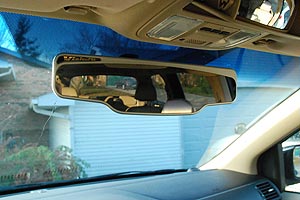“Recovery after loss of one eye requires an adjustment to monocular vision and resolution of a significant, serious emotional trauma."
- Linberg
The Monocular Patient
Bioptic Driving with Only One Eye
We must start by noting that there are thousand of “unrestricted” drivers who have vision in only one eye. In Indiana we are able to prescribe bioptics for monocular patients, who have vision in only one eye. Licensing of monocular bioptic drivers may vary by state.
One key in deciding if the monocular patient is a candidate for bioptic driving is the amount of side vision in the functional eye. One eye alone with a “normal” visual field may have 140 to 160 degrees of visual field. The limits are the size of the bridge of the nose and the depth the eye is recessed into the orbit. As you will see in the animation below, a patient with one eye will have a 20 to 40 degree defect on the far side of the loss. This visual loss is compensated for as the patient shifts the eyes or head back and forth.
Another key is the patient’s prior experience as a monocular patient. A patient who has been monocular from birth for at least for a number of years can be a better candidate than a patient who has only recently become monocular. A visually impaired patient with recent total vision loss in one eye may require a period of time to adapt to the compensations needed in adjusting to the recent loss. If a patient has driven in the past as a monocular driver when vision was better in the remaining eye, this may make transition to bioptic driving much easier.
The patient’s ability to scan may be further enhanced through simple exercises like descriptive driving plus additional mirrors may be added to the car including a panoramic mirror angled to the side of the loss and wide view external mirrors.
During the  behind-the-wheel evaluation, a certified driving rehabilitation specialist will address the patient’s real world ability to compensate. In Indiana, patients undergo 30 hours of behind-the-wheel training.
behind-the-wheel evaluation, a certified driving rehabilitation specialist will address the patient’s real world ability to compensate. In Indiana, patients undergo 30 hours of behind-the-wheel training.
The monocular patient also experiences a loss of depth perception. However, since most bioptic drivers lack depth perception due to their decrease in visual acuities, the loss of depth perception in monocular patients after a period of adaptation is only a slightly greater problem than in other binocular bioptic drivers.
Monocular patients learn to use non ocular depth perception. While we test ocular depth perception in clinical settings with careful controls on other cues, in the real world drivers use other cues to judge depth.
